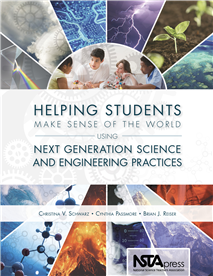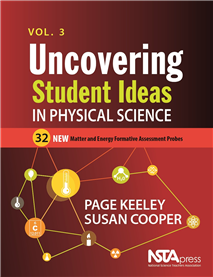All Resources
Book Chapter
The greenhouse effect is critical to understanding the basic mechanism of global warming. This session uses two types of models to help students understand the key concept of the greenhouse effect and the role that CO2 plays. Students then analyze da...
Book Chapter
Fact or Phony? Scientifically Evaluating Data
This session begins by students looking at a purely fictional web page cleverly disguised as factual. Students are challenged to learn important information from the web page to decide if it is factual. The session addresses the need to evaluate accu...
Book Chapter
Conducting Research on Current Climate Change Topics
This session leverages the power of student discovery, viewed through the lens of the Next Generation Science Standards (NGSS), to support students’ awareness of the complex nature of a warming planet. Students begin the session by forming research...
Book Chapter
In this session, students engage in a mock scientific conference to demonstrate another aspect of the work of scientists—sharing work with peers and seeking critical review. The mock conference provides an opportunity for students to present their ...
Book Chapter
This session provides an opportunity for students to integrate the information they have learned from their research. They create charts or mind maps to anticipate the ripple effects from an aspect they have studied. They consider the secondary effec...
Book Chapter
This session is about hope. After students learned a great deal about the serious implications of a warming planet, it is important for them to have reasons to be hopeful and to see solutions that are being implemented and planned for the sustainabil...
Book Chapter
This session brings together all that students have learned to provide them with concrete actions they can take to make a difference in their own lives and communities. The session begins with students calculating their own carbon footprint and compa...
Virtual Conference
Science and Engineering Practices: Professional Book Study for Elementary School Teachers
Are you an elementary school teacher working to enhance your knowledge and understanding of the Science and Engineering Practices from A Framework for K-12 Science Education and the Next Generation Science Standards (NGSS)? Register to participate in...
Journal Article
Middle School Girls Gain Confidence, Competence, and Interest Through Summer STEAM Camp
To combat the well-researched and documented drop in interest and confidence in STEM (science, technology, engineering, and math) that girls tend to experience in their middle school years, the Plum Borough School District, as part of the ABC CREAT...
By Tamar McPherson, Stephanie Reilly, and Colleen Smith
Journal Article
KEYS High School Student Internship Program
By Marti Lindsey, Heather Ingram, and Bob Mittan
Journal Article
Where can a middle school girl wield a chop saw or welder in one moment, and build her interpersonal and self-advocacy skills in the next? For 20 years, Rosie’s Girls, a program of Vermont Works for Women, has helped girls and gender-nonconformin...
By Alison Lamagna
Book Chapter
The purpose of this assessment probe is to elicit students’ ideas about the concept of matter. It is designed to understand how students define matter and whether they recognize that all living, once-living, and nonliving things, materials, or subs...
Book Chapter
The purpose of this assessment probe is to elicit students’ ideas about the concept of matter. It is designed to find out how students define matter and whether they recognize that all three states—solids, liquids, and gases—are matter. It is b...
Book Chapter
What Do You Know About Atoms and Molecules?
The purpose of this assessment probe is to elicit students’ ideas about atoms and molecules. It is designed to reveal commonly held ideas students have about the structure and properties and provides students an opportunity to use the scientific p...
Book Chapter
The purpose of this assessment probe is to elicit students’ ideas about the size (in diameter) of atoms. It is designed to reveal how students use the crosscutting concept of scale to compare relative sizes by estimating size in general and using o...
Book Chapter
The purpose of this assessment probe is to elicit students’ ideas about the particle model of matter. The probe is designed to find out if students recognize that air is made up of particles that are widely spaced with empty space between the parti...
Book Chapter
What If You Could Remove All the Atoms?
The purpose of this assessment probe is to elicit students’ ideas about the particle model of matter. The probe is designed to find out if students recognize that there is empty space between the atoms that make up an object and that the atoms are ...
Book Chapter
Do They Have Weight and Take Up Space?
The purpose of this assessment probe is to elicit students’ ideas about extensive properties. It is designed to determine whether students recognize that weight (or mass) and volume are extensive properties of the three familiar states of matter. T...
Book Chapter
What Does “Conservation of Matter” Mean?
The purpose of this assessment probe is to elicit students’ ideas about the phrase conservation of matter. It is designed to find out how students interpret the word conservation in the context of matter. The probe is best used with grades 5–12. ...
Book Chapter
The purpose of this assessment probe is to elicit students’ ideas about the conservation of matter. The probe is designed to find out if students conserve matter when salt is dissolved in water. It is best used with students in grades 3–12, with ...
Book Chapter
The purpose of this assessment probe is to elicit students’ ideas about density. The probe is designed to find out whether students recognize a change in the mass-volume ratio when the volume changes and the mass stays the same. It is best used wit...
Book Chapter
The purpose of this assessment probe is to elicit students’ ideas about density. It is designed to find out whether students have commonly held ideas about mass, volume, shape, and other properties that interfere with their conceptual understanding...
Book Chapter
The purpose of this assessment probe is to elicit students’ ideas about mass. It is designed to find out if students understand the difference between mass and other properties. The probe is best used with students in grades 6–12, and can be used...
Book Chapter
Do They Have the Same Properties?
This assessment probe is to elicit students’ ideas about microscopic and macroscopic properties of matter and is designed to find out if students attribute the same properties of a substance to the particles that make up the substance. The probe is...
Book Chapter
This assessment probe is to elicit students’ ideas about characteristic properties of matter. It is designed to find out if students recognize some properties can be used to identify a substance. The probe is best used with students in grades 6–1...
Book Chapter
The purpose of this assessment probe is to elicit students’ ideas about elements and compounds. It is designed to find out how students classify a common substance, water. The probe is best used with students in grades 5–12, preferably after they...
Book Chapter
Graphite is the material in a pencil tip, and diamonds are precious jewels. They are both made of carbon. This assessment probe is to elicit students’ ideas about two seemingly different substances that are composed of the same element. It is desig...
Book Chapter
The purpose of this assessment probe is to elicit students’ ideas about neutral atoms. The probe is designed to reveal how students think about the relationship between fundamental particles inside the nucleus of an atom. It is best used with stude...
Book Chapter
The purpose of this assessment probe is to elicit students’ ideas about substances. The probe is designed to determine whether students distinguish between the everyday use of the word substance and how chemists use the word to refer to matter with...
Book Chapter
When matter changes, sometimes a new substance is formed. The purpose of this assessment probe is to elicit students’ ideas about chemical change. The probe is designed to find out how students determine whether a new substance with a different che...
Book Chapter
What Is the Result of a Chemical Change?
The purpose of this assessment probe is to elicit students’ ideas about chemical change. The probe is designed to find out whether students recognize that substances change chemically as a result of a chemical reaction. It is best used with student...
Book Chapter
What Happens to Atoms During a Chemical Reaction?
The purpose of this assessment probe is to elicit students’ ideas about chemical change. The probe is designed to find out whether students recognize that the same kinds and numbers of atoms are present before and after a chemical reaction. It is b...
Book Chapter
Observations provide evidence of a chemical change. The purpose of this assessment probe is to elicit students’ ideas about chemical change. The probe is designed to find out what changes students use as evidence of a chemical change. It is best us...
Book Chapter
The purpose of this assessment probe is to elicit students’ ideas about changes that result in new properties. The probe is designed to find out whether students recognize that some things mixed together will retain their properties and others will...
Book Chapter
This assessment probe is to elicit students’ ideas about radiation and is designed to reveal whether students distinguish between something that had been exposed to radiation (irradiated) versus something that is radioactive. It is best used with s...
Book Chapter
This assessment probe is to elicit students’ ideas about radiation and is designed to reveal how students distinguish between irradiated and radioactive material. It is best used with grades 9–12 and should be followed up with opportunities for d...
Book Chapter
Energy is difficult to define. The purpose of this assessment probe is to elicit students’ ideas about energy and is designed to reveal how students define or describe energy. This probe is best used with students in grades 4–12. When used with ...
Book Chapter
This assessment probe is to elicit students’ ideas about matter and energy and is designed to uncover students’ ideas about the similarities and differences between the crosscutting concepts of matter and energy. This probe is best used with stud...
Book Chapter
This assessment probe is to elicit students’ ideas about energy and chemical bonds and is designed to find out how students think about the release of energy involved in chemical bonding. It is best used with grades 9–12, and it may help to provi...





